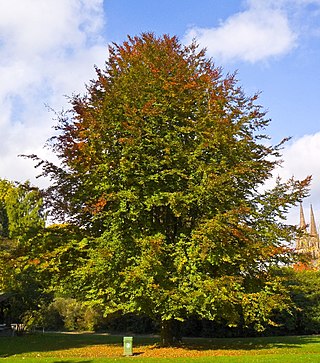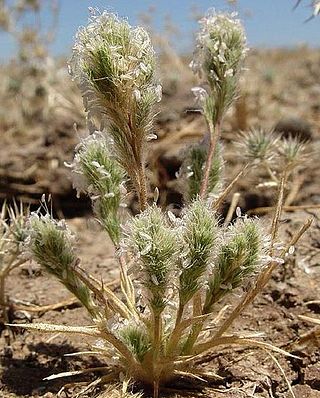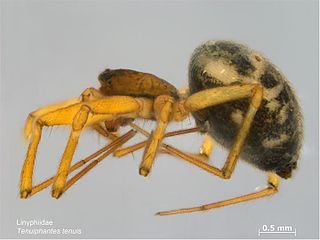
The Fagaceae are a family of flowering plants that includes beeches, chestnuts and oaks, and comprises eight genera with about 927 species. Fagaceae in temperate regions are mostly deciduous, whereas in the tropics, many species occur as evergreen trees and shrubs. They are characterized by alternate simple leaves with pinnate venation, unisexual flowers in the form of catkins, and fruit in the form of cup-like (cupule) nuts. Their leaves are often lobed and both petioles and stipules are generally present. Their fruits lack endosperm and lie in a scaly or spiny husk that may or may not enclose the entire nut, which may consist of one to seven seeds. In the oaks, genus Quercus, the fruit is a non-valved nut called an acorn. The husk of the acorn in most oaks only forms a cup in which the nut sits. Other members of the family have fully enclosed nuts. Fagaceae is one of the most ecologically important woody plant families in the Northern Hemisphere, as oaks form the backbone of temperate forest in North America, Europe, and Asia, and are one of the most significant sources of wildlife food.

Bromus is a large genus of grasses, classified in its own tribe Bromeae. They are commonly known as bromes, brome grasses, cheat grasses or chess grasses. Estimates in the scientific literature of the number of species have ranged from 100 to 400, but plant taxonomists currently recognize around 160–170 species.

Juncus tenuis, the slender rush, is a clump-forming, round-stemmed perennial in the Juncaceae. Slender rush grows to be between 15 and 60 cm tall. Generally considered a weed, it is rarely sold by retailers as a household container plant. Where it is introduced, it is colloquially called path rush, field rush, slender yard rush, poverty rush or wiregrass.

The slender catshark is a small species of catshark belonging to the family Scyliorhinidae. It is found on the upper continental slope off the coast of Suriname, French Guiana and northern Brazil, including the mouth of the Amazon River at depths between 72 and 450 metres. Its it can grow up to a length of 70 centimetres (28 in).
Ptilidium californicum, the Pacific fuzzwort, is a rare liverwort of the western United States.

The slender squirrel is a species of rodent in the family Sciuridae. It is arboreal and found in Indonesia, Singapore, Malaysia, and Thailand. The body is brown on the upper parts and light grey on the underparts. The body measures about 13–16 cm, with a slightly shorter slender tail. It feeds on soft bark, fruits and insects.

Tuctoria is a genus of three species of grass in the family Poaceae. Spiralgrass is a common name for plants in this genus. These are bunchgrass species that are found in vernal pools of central California and Baja California, Mexico. The plants are annuals that germinate under water in the spring and grow submerged for weeks. After the pools dry down, the grasses initiate a new set of foliage that lasts for one to two months until flowering and fruiting are complete.

Orcuttia is a genus of grass in the family Poaceae. Plants grow up to 20 cm (8 in) tall, usually with many stems emerging from the base of the plant, and forming a tuft. The spikelets are several-flowered, with reduced upper florets. The lemma tips have between two and five teeth.

Nemacladus is a genus of flowering plants in the bellflower family known generally as threadplants. Species are native to the southwestern United States and northern Mexico. These are annual herbs with very slender, sometimes threadlike, branching stems bearing small five-lobed flowers.

Orcuttia californica is a rare species of grass known by the common name California Orcutt grass.
Orcuttia inaequalis is a rare species of grass known by the common name San Joaquin Valley Orcutt grass.

Orcuttia viscida is a rare species of grass known by the common name Sacramento Orcutt grass.
O. californica may refer to:

Charles Russell Orcutt or C.R. Orcutt was a noted naturalist sometimes called "cactus man" because on many expeditions he found new species of cacti. He was active in the San Diego Society of Natural History, promoting the foundation of a local natural history museum, now the San Diego Natural History Museum. He edited the American Botanist (1898-1900), American Plants (1907-1910), and Western Scientist (1884-1919) and in his collecting work, made contributions to the fields of botany and malacology.

Tenuiphantes tenuis is a species of spider belonging to the family Linyphiidae. Its native distribution is reported as Europe, Macaronesia, Northern Africa, Turkey, Caucasus, Central Asia. The species was introduced to USA, Chile, Argentina and New Zealand from Europe where it is found throughout.

Cynodonteae is a large tribe of grasses in the subfamily Chloridoideae, with over 800 species.
Eucalyptus tenuis is a species of slender mallet that is endemic to the southwest of Western Australia. It has smooth bark, lance-shaped adult leaves, flower buds in groups of three, creamy white flowers and conical, cup-shaped or bell-shaped fruit.

Dudleya hendrixii is a rare succulent plant known by the common name Hendrix's liveforever. It was discovered in late 2016 by researchers from San Diego State University and University of California, Santa Cruz.

The Phoenix Vernal Pools are located in Fair Oaks, California, a suburb of Sacramento city around 20 miles east of the city of Sacramento and north of highway 50. This land consists of seasonally inundated wetlands that form after winter rains. The climate type of Phoenix Vernal Pools is classified as Mediterranean, receiving 24 in (610 mm) of rain per year. The rainwater percolates into the soil until it reaches an impermeable hardpan that causes an elevated water table, forming the vernal pools. The Phoenix Vernal Pool ecosystem is relatively unique as is supports many species of fauna and flora endemic to vernal pools.

Tragus racemosus, commonly referred to as stalked bur grass, European bur grass, or large carrot seed grass, is a species of grass native to Europe. It is often confused with a similar plant of the same genus, Tragus berteronianus. It is a monocot and is considered a weed in many countries and is a relatively uncommon seed contaminant.

















